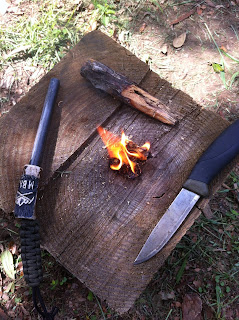Lighter’d.
That’s what
we were taught that it was.
Any Southern boy worth his salt knew … and still
knows … what lighter’d is. I don’t know where the term “fat wood” came from or
when it came into use to describe this valuable resource.
What it’s called doesn’t
change its nature. Knowing its nature and where to find it is what’s important.
Finding good
lighter’d is not hard to do where there are stands of Longleaf Pine.
Longleaf is
especially resinous and harder than most pines.
 I am
fortunate to have access to a good bit of lighter’d. More than a good bit. A
lot of bit. At least for the time being.
I am
fortunate to have access to a good bit of lighter’d. More than a good bit. A
lot of bit. At least for the time being.
The lighter’d
pine top in the first picture is the remains of a Longleaf that fell victim to
Hurricane Frederic a few decades ago. The other object in this first picture is
the remnants of a lighter’d fence post that finally rotted off at ground level.
Everything above ground is as solid as the day my grandfather set that post.
The problem
with Longleaf, at least with the timber industry, is that Longleaf is terribly
slow growing. The industry remedy for the slow growing Longleaf was to replace
stands with faster growing pines cultivated for the needs of the industry. That’s good for the industry but it’s not so good for
those of us that like to pick lighter’d for our firemaking purposes.
 The faster
growing pines are soft and not as resinous. Their stumps rot in the ground leaving
behind leg breakers and ankle busters where trees once grew. Trees fallen on the
ground simply rot away. It doesn’t take them long, at least in the larger
scheme of time, to rot away and “return to the earth.”
The faster
growing pines are soft and not as resinous. Their stumps rot in the ground leaving
behind leg breakers and ankle busters where trees once grew. Trees fallen on the
ground simply rot away. It doesn’t take them long, at least in the larger
scheme of time, to rot away and “return to the earth.”
Several of
the lawns that I’ve taken care of over the years have the less resinous softer pines
growing in and around them. One of the things I noticed was something that
happened when I skinned their roots with my mower blades. They oozed resin.
So it got me
to wondering.
I wondered
how these green roots, if chopped out and allowed to dry, would perform as
lighter’d.
I chopped
out a small root, threw it into my truck, and honestly forgot about it. It rode
around with me for several months before I noticed it on the floorboard and
gave it a try.
 That small
piece of pine root looked like good lighter’d, smelled like good lighter’d,
shaved and scraped like good lighter’d, and, hit with a good spark from my ferro
rod, performed like good lighter’d. It had, indeed, dried out and become
lighter’d.
That small
piece of pine root looked like good lighter’d, smelled like good lighter’d,
shaved and scraped like good lighter’d, and, hit with a good spark from my ferro
rod, performed like good lighter’d. It had, indeed, dried out and become
lighter’d.
So I’m
wondering again.
How do
Northern pine and spruce roots perform when taken green and allowed to dry?
Maybe
someone can do some experimenting and post their results.

No comments:
Post a Comment